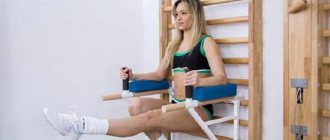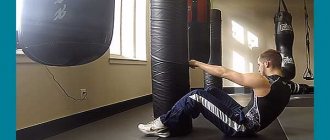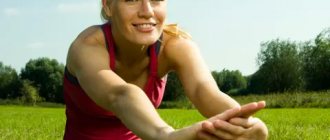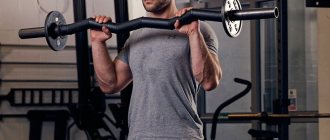Even the most useful thing in the world will be just a decoration if you don’t know how to use it correctly. We'll tell you about the best exercises of varying difficulty that your children can do on the wall bars.
Even simple wall climbing helps relieve stress and get rid of muscle tension that appears from sitting motionless at a desk or in front of a computer. Regular exercises that a child performs on the wall stimulate his immunity, as well as the development of physical and intellectual abilities. It is also worth mentioning that climbing up and down stairs strengthens the arch of the foot, which prevents flat feet.
Depending on the purpose for which it is used, the wall will become a strength or stretching trainer, a reason for morning exercises, or a way to relax before bed. The main thing is to show the child (you can use a personal example) how to use it with benefit and pleasure.
A nuance: all walls are useful, but the more modern and safe the option is installed in your home, the calmer you are for a child, even a small one who is not prepared for serious training. If you purchase a variety of equipment along with the wall: rope ladders, ropes, rings, horizontal bars, slides, swings, it will be more fun and interesting for your child to do the exercises.
On our website you can buy an excellent wall bars for a child that will meet all standards and safety requirements, and will fit perfectly into your apartment and will look appropriate and aesthetically pleasing.
Exercises for morning exercises
- Mini pull-ups
: rest your feet on the base of the wall, place your hands on the bar at shoulder level and straighten them completely. Then we pull ourselves close to it, the grip can be changed, for example, placing your hands narrower or wider, grabbing the bars not from above, but from below - this will help to use all the small muscles of the hands. We perform mini-pull-ups 10-15 times. - Warming up the feet
: stand on the lower bar, hold your hands at a comfortable height. We step our feet for a minute, as if walking in place. Then we move our feet forward / backward - from toes to heels. - Tilts to the wall
: place your left hand on the crossbar of the wall bars at shoulder level or slightly lower and stand sideways to it. Then we tilt our body to the left, while trying to reach the crossbars with our straight right hand, but do not turn our body. We perform 10 times, and then repeat 10 more times - this time for the right side of the body. - Squats on the bar
: stand with your feet on the bottom step of the wall bars, grab the bar at chest level with your hands and squat 10-15 times.
Before and after morning exercises, invite your child to hang on a bar or horizontal bar (if available) for at least 20-30 seconds. The exercise seems simple and even boring, because you don’t need to do anything, but it is one of the most useful for straightening the spine, as well as strengthening the muscles of the back, shoulders and arms. Gradually increase the duration of the hang. The ability to hold out for 5 minutes is aerobatics!
What types of “Ladder” are there?
The above definition refers to the so-called ascending “Ladder”, since the number of repetitions in each series increases. If you start performing a physical complex with a series of a large number of repetitions (for example, 10), and then reduce this number with each subsequent approach, then they talk about a descending “Ladder”.
Any other variations of this training complex are a combination of the ascending and descending “Ladder”. Thus, a complex is often performed in which the number of repetitions of an exercise in a series is first increased to a certain value, and then reduced to the original number. Another type of “Ladder” is multiple repetitions up and down; this option is usually denoted by the Latin letter W indicating the maximum number of “steps”, for example, W8.
The “Ladder” exercise is most often used during exercises on the horizontal bar, during push-ups, and also during squats. Let's consider each of these types of exercises, taking into account its implementation in the form of a “Ladder”.
Exercises for a healthy back and correct posture
Children sit at their desks a lot without controlling the correct position of their backs. In addition, an “on duty” tilt towards the screen of a tablet or smartphone can lead to muscle tension in the neck and even curvature of the spine. The Swedish wall of the house is the key to a healthy back.
- We stand with our backs to the wall, breathe evenly and calmly, and focus on how each bar touches our back.
- We hang on the crossbar, which is convenient in height, for a minute. If it takes longer, great!
- Hanging on rings (if available) - this type of hanging adds variety to the usual training program and uses muscles that do not work when hanging on a stationary bar.
- We do the plank. To do this, we hook our feet to the first or second bar, place our hands on the floor or on the mat - and stand motionless for at least 20-30 seconds. The correct technique is important: make sure that the child’s lower back does not bend down and the pelvis does not go up. The correct bar is straight.
- We hang facing the wall bars and lift our pelvis and straight legs away from it. We fix the “vertical boat” for 1-2 seconds, then return to the starting position. Repeat 5-7 times.
- We stand facing the wall, place our feet near the bottom crossbar, and grab with our hands at waist level or slightly lower. Then we lean forward, moving the body and pelvis back, and keeping the back straight. We fix the position at the extreme point for 2-3 seconds, then return to the original vertical position. Repeat 5-7 times.
"Ladder" for legs
It is very rare to find an athlete who practices the “Ladder” exercise for the legs. Here, as in previous cases, various variations in the implementation of the physical complex are possible. Interestingly, it is customary to perform squats differently than a similar exercise with push-ups or pull-ups.
It is done like this: the athlete gets into the starting position for performing squats and does one repetition, counts a second, then does two repetitions, counts two seconds, does three squats, and so on. That is, the more squats are performed, the more the athlete rests between series.
Exercises for strong muscles
Home workouts on the wall bars can become a backup option and an alternative to sports clubs in case of self-isolation, quarantine at school, or a vacation break. And, of course, regular exercise at home will improve your child’s physical education grades over time.
- We stand with our backs to the wall bars. We grab the bar, high enough so that our feet do not touch the floor, and hang by our hands. Slowly, without jerking, we raise our legs bent at the knees perpendicular to the body. Repeat 10-15 times.
- The starting position is the same, raise straight legs 8-10 times.
- The starting position is the same, in turn we pull our knees to the opposite shoulders. Repeat 8-10 times on each side.
- The starting position is the same, in turn we raise our legs straight to the sides - 10-15 times on each side.
- We turn to face the wall, grab high with our hands, hang and then bend both legs at the knees, trying to touch the buttocks. Repeat 10-15 times.
- We stand with our right side to the wall, place our straight right leg on the crossbar at the level of the pelvis or slightly lower (the higher the crossbar, the higher the load, so choose the height taking into account the child’s physical fitness). We squat on the left leg 5-7 times. Then we turn to our left side and squat on our right leg. It is important to distribute the load correctly: it should not fall on the knee joints, so make sure that the child keeps his back straight and, during the squat, moves his pelvis back, and the knee does not go far forward.
- We do lunges: we stand with our back to the wall bars, step our right foot far forward (the angle at the knee is 90 degrees), then lunge with our left foot. Repeat 5-7 times on each leg.
- We lie down on the mat perpendicular to the wall, fasten our legs to the bottom bar, and perform 10-15 abdominal crunches.
Why study self-esteem?
Self-esteem is a very important indicator in personality development. This is how a person evaluates himself, his qualities, and abilities.
Self-esteem is formed in the process of communication and activity; it influences a person’s behavior and actions in a given situation.
At preschool age, a child is just beginning to recognize himself, mainly from the assessments and opinions of others, which may not always be correct and correspond to reality. This results in inadequate self-esteem, which can be either underestimated or overestimated.
Any distortions entail difficulties in further communication and activities, so it is important to monitor and correct them in a timely manner. One of the ways to study self-esteem is the “Ladder” technique by V.G. Shchur.
Exercises to develop flexibility
- We stand facing the wall bars at an outstretched leg distance, place our right foot on the crossbar and lean our body towards it. Repeat 3-5 times. We perform it in 2 passes: first with a round back, then with a straight back.
- We perform a “pendulum”: hang by our hands with our backs to the wall, swing our legs from side to side, keeping them together. The amplitude should not be large. Make sure that the child’s movements are not sharp or impetuous.
- We make a “bridge”: we stand with our back to the wall bars at a distance of 2 steps, grab the bar with one hand, and “step” lower with the other - and so on until the stretching is enough. Do not rush to perform a full bridge, wait until the child’s muscles stretch and get stronger, and he himself does not feel fear hanging in an unusual position.
- We stand at arm's length facing the wall and grab the bar with both hands. Feet together. Keeping your arms straight, lean forward, then take turns slightly bending your legs.
Finger position
There is a common belief that you should always use an open grip for hanging, but this is not very similar to the real picture of climbing. The ladder training system uses three grips: open, semi-open and closed or active - these are the grips most commonly used in climbing and are more consistent with the principle of specificity. The fact is that isometric training gives results almost only for the position of the joint that was used in training. By hanging in all three positions, we are guaranteed to increase the strength of any grip we use while climbing. It doesn’t matter how consciously we try to keep an open or at least half-open grip - when it’s really necessary, we pinch our fingers into the action. The point is to train it carefully in controlled conditions rather than tempting your fingers on the track.
Open grip
The second knuckle is below the level of the first knuckle, used on good shelves and passives, with this grip we spend the least amount of force.
Half-open grip
Both joints are at the same level, which requires medium effort.
Closed grip
The second joint is higher than the first and requires the most effort.
Playful exercises for little ones
- “The monkey is naughty”
: we hang on the crossbar, hold on with both hands for 10-15 seconds, then “walk” (we let go of one or the other hand for a while, while the parent protects against falling). We repeat the “steps” 3-4 times for each hand. - “The clock is ticking”
: we perform the “pendulum” exercise - we swing slightly from side to side, holding on with both hands. Legs together and straight. - “The fish swims”
: we hang on the crossbar or horizontal bar (if available) and make rotational movements with our legs. 2-3 circles clockwise, then 2-3 circles counterclockwise. - “The grass is growing”
: we hang on the crossbar and pull ourselves up to it (the parent belays and slightly pushes the child up). Repeat 2-3 times. - “Vanka-Vstanka is training”
: we do squats near the wall bars. We stand facing her, holding our hands at waist level. Repeat 5-6 times. - “An astronaut climbs into a rocket”
: we climb the rope ladder. Repeat 1-2 times. - “Pirates attack”
: we climb the rope (with the help of a parent) or swing on it, holding on tightly with our hands. - “The swallow is flying”
: we stand with our feet on the bottom bar, facing the wall bars. We hold our hands at chest level. Raise your head up, arch your back and move your straight right leg back as far as possible. We fix the position for 1-2 seconds, then raise the left leg.
On our website you can buy an excellent wall bars for a child that will meet all standards and safety requirements, and will fit perfectly into your apartment and will look appropriate and aesthetically pleasing.
Safety precautions
When practicing with your child on the wall bars, follow simple rules.
- Before purchasing a wall bars and before starting home workouts, consult your pediatrician. Even such a useful sports equipment has contraindications.
- Be sure to warm up before doing the exercises: perform rotational movements with your head, shoulders, arms, and hands. Rotate your feet. Get up on your toes and go down. Do 2-3 body tilts in each direction.
- Take care of a soft landing: lay a high-quality, dense mat near the wall bars.
- Complicate the exercises and increase the number of approaches gradually. At the same time, make sure to perform the exercise correctly.
- End your workouts with a little stretching (see section above), otherwise your child will have sore muscles the next day and will not want to repeat the “unpleasant” experience.
- Don't force it! There will be little benefit from “I don’t want to” exercises.
- Don't exercise immediately after eating. Wait at least 30-40 minutes.
- Do not practice on the wall bars if your child is overexcited: concentration will decrease and the risk of injury will increase.
- Avoid exercising if you feel unwell.
- Insure your child: a child under 4-5 years old - constantly, an older child - during complex exercises and when climbing to heights.
conclusions
Using the "Ladder" it is possible
- determine self-esteem and level of life adaptation of children;
- prevent the occurrence of problems, correct deviations of self-esteem from the norm;
- teach students to interact with each other while completing a common task;
- create teams where children independently choose a role and test each other;
- teach children to positively evaluate the results of their activities.
Self-esteem is an important indicator of personality. Children of primary school age form an idea of themselves and determine their place among others. Using self-esteem diagnostic methods, an adult can promptly detect problems in a child’s sense of self. The research results help correct the student’s behavior, teach them to adequately assess their own capabilities, discover new abilities, and develop the process of self-knowledge.










